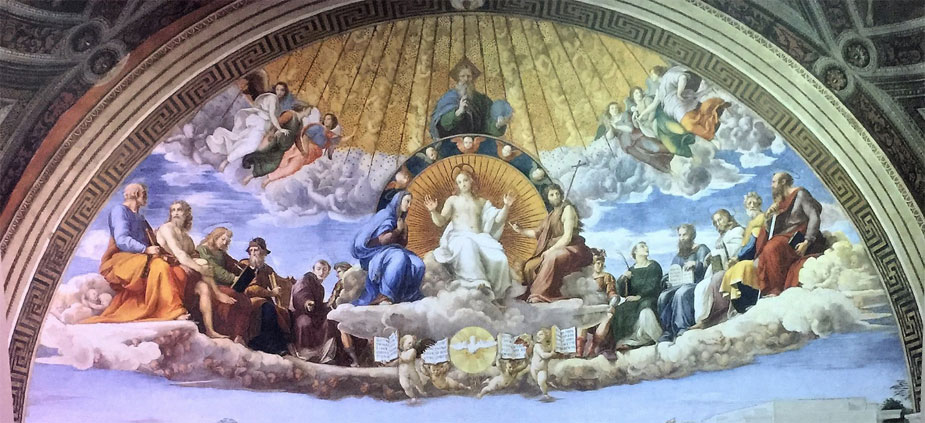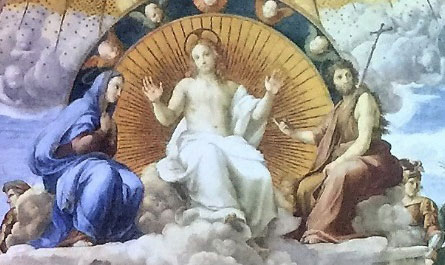By Lucinda Herrick
In my last article, I presented a brief overview of the wonderful copy of Raphael’s famous fresco which adorns the wall of our Adoration Chapel. This time we continue our study of the Disputation of the Holy Sacrament and will explore the reasons behind specific elements in the work.
Pope Julius II (1443-1513) commissioned this fresco, along with several others, for his library in the Apostolic Palace. It was not created for view by the laity, but for the Pope’s personal edification. Today, however, it is seen daily by thousands of visitors to the Vatican Museum, allowing us to learn of the ways Raphael used artistic devices and symbols to teach us, the viewer, about the Holy Sacrament.

Why use art to teach religious truths? Until the 15th century and the development of the printing press, art was a principal teaching tool as few people could read or write. Thus, specific depictions and symbols became synonymous with certain saints, religious figures and sacred objects.
Raphael uses line to draw our eyes to the center of the painting. The figures in the earthly scene are positioned to curve from each corner toward the center, thus drawing our focus on the Monstrance holding the Host, the Body of our Lord. In the heavenly scenes, the same curvilinear rows of Saints, lead our eyes toward Christ enthroned with the dove of the Holy Spirit at His feet, while God the Father is flanked by six angels who lean toward Him as clouds roll inward and streams of golden light, filled with cherubs, fall from the dome of Heaven. Raphael has placed the Father, Son, Holy Spirit and Holy Eucharist in a straight line, from the top to the center of the painting, indicating they are One and are welded together like a precious chain to be the center of our spiritual life.
God, the Father is placed at the top of the Holy Trinity. It wasn’t until the 14th century that God the Father was depicted as a man in art as He is, according to Christ, unseen (Matt. 11:27, John 6:46, John 14:6). However, being an artist of the Renaissance, Raphael has depicted The Father as an old man with a triangular nimbus/halo, emphasizing the Trinity. In his left hand he holds a sphere representing the world and with His right He imparts a blessing to those below, including His Son and the Holy Spirit.
The representation of Christ on His throne has been used by artists since the 4th century and portrays His status as “King of Kings and Lord of Lords” (Rev. 19:16). His raised hands display the wounds of His crucifixion, emphasizing His shedding of blood for our sins.
In art, the Holy Spirit can be depicted by several forms of iconography. Raphael has chosen two of those forms: fire and a dove. Fire symbolizes the transforming energy of the Holy Spirit’s actions within a soul. The dove first appeared at Christ’s baptism as the Spirit of God descending from heaven (CCC 701, Matt. 3:16). Flanking the dove, representing the Holy Spirit, are four putti (cherubs) holding the four Gospels.
The Host in the monstrance on the altar is the final link in this precious chain which connects heaven with earth, God with man. It is the Real Presence of Christ and emphasizes the intimate relationship between Christ and His believers on earth, uniting them and keeping them united.
As we quietly contemplate our Lord’s holy sacrifice, let us keep in mind this great mystery, the mystery of the Holy Trinity (John 14:1-31).
www.artsy.net/article/artsy-editorial-happened-catholic-churchs-art-patronage
www.catholic.com/encyclopedia/eucharist


Nice job Lucinda! You truly expressed through your words what this Fresco means. It is so helpful to be able to understand and visualize now.
Thank you for opening my eyes to this beautiful piece!
God bless you,
Tina